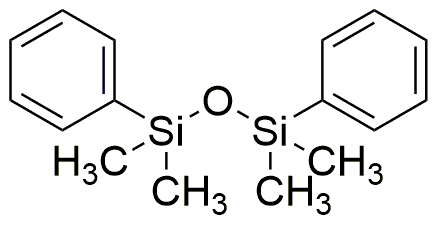1,1,3,3-Tetramethyl-1,3-diphenyldisiloxane is widely utilized in research focused on:
- Silicone Production: This compound serves as a key intermediate in the synthesis of silicone polymers, which are used in various applications including sealants, adhesives, and coatings.
- Surface Modification: It is effective in modifying surfaces to enhance hydrophobicity and oleophobicity, making it valuable in industries like textiles and electronics.
- Cosmetic Formulations: Its unique properties make it a popular ingredient in cosmetic products, providing a smooth texture and enhancing the spreadability of creams and lotions.
- Thermal Stability: The compound is used in high-temperature applications due to its excellent thermal stability, making it ideal for automotive and aerospace industries.
- Research Applications: In laboratories, it is often utilized as a reagent in organic synthesis and materials science, helping researchers develop new compounds and materials.
General Information
Properties
Safety and Regulations
Applications
1,1,3,3-Tetramethyl-1,3-diphenyldisiloxane is widely utilized in research focused on:
- Silicone Production: This compound serves as a key intermediate in the synthesis of silicone polymers, which are used in various applications including sealants, adhesives, and coatings.
- Surface Modification: It is effective in modifying surfaces to enhance hydrophobicity and oleophobicity, making it valuable in industries like textiles and electronics.
- Cosmetic Formulations: Its unique properties make it a popular ingredient in cosmetic products, providing a smooth texture and enhancing the spreadability of creams and lotions.
- Thermal Stability: The compound is used in high-temperature applications due to its excellent thermal stability, making it ideal for automotive and aerospace industries.
- Research Applications: In laboratories, it is often utilized as a reagent in organic synthesis and materials science, helping researchers develop new compounds and materials.
Documents
Safety Data Sheets (SDS)
The SDS provides comprehensive safety information on handling, storage, and disposal of the product.
Product Specification (PS)
The PS provides a comprehensive breakdown of the product’s properties, including chemical composition, physical state, purity, and storage requirements. It also details acceptable quality ranges and the product's intended applications.
Certificates of Analysis (COA)
Search for Certificates of Analysis (COA) by entering the products Lot Number. Lot and Batch Numbers can be found on a product’s label following the words ‘Lot’ or ‘Batch’.
*Catalog Number
*Lot Number
Certificates Of Origin (COO)
This COO confirms the country where the product was manufactured, and also details the materials and components used in it and whether it is derived from natural, synthetic, or other specific sources. This certificate may be required for customs, trade, and regulatory compliance.
*Catalog Number
*Lot Number
Safety Data Sheets (SDS)
The SDS provides comprehensive safety information on handling, storage, and disposal of the product.
DownloadProduct Specification (PS)
The PS provides a comprehensive breakdown of the product’s properties, including chemical composition, physical state, purity, and storage requirements. It also details acceptable quality ranges and the product's intended applications.
DownloadCertificates of Analysis (COA)
Search for Certificates of Analysis (COA) by entering the products Lot Number. Lot and Batch Numbers can be found on a product’s label following the words ‘Lot’ or ‘Batch’.
*Catalog Number
*Lot Number
Certificates Of Origin (COO)
This COO confirms the country where the product was manufactured, and also details the materials and components used in it and whether it is derived from natural, synthetic, or other specific sources. This certificate may be required for customs, trade, and regulatory compliance.


